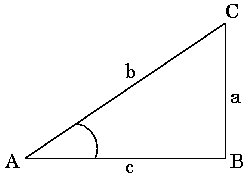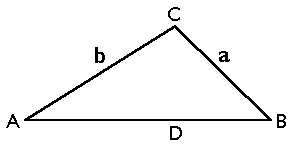
The ambiguous case in trigonometry calls for the solution of triangles when given two sides and a nonincluded angle. There can be two possible triangles with the given measures.
Equation: a/sinsA = b/sinB = c/sinC

Refer to triangle ABC on the right, for the first example.
Ex. 1 If angle A equals 33, a equals 11, and angle B equals 56, find side b.
Some of these were on the wrong page, but the above information is accurate, and I will fix examples shortly, probably this weekend, thanks.
| Step 1: | Set up the equation | 11/sin33 = b/sin56 |
|---|---|---|
| Step 2: | Cross multiply | bsin(33) = 11sin(56) |
| bsin(33) = 9.12 | ||
| Step 3 | Isolate b by division | b = 9.12/sin(33) |
| b = 16.75 |

Use the right triangle to the left for example 2.
Ex 2 If side c equals 27, and side a equals 13, find angle A.
| Step 1: | Set up your equation | 27/sin(90) = 13/sinA |
|---|---|---|
| Step 2: | Cross multiply | 27sinA = 13sin(90) |
| 27sinA = 13 | ||
| Step 3 | Isolate b by division | sinA = 13/27 |
| Step 4 | Take the inverse sine of A | sin-1(sinA) = sin-1(13/27) |
| A = 28.78 degrees |
Here are a few other websites you might find useful:
Geocitites, Ambiguous case.Pink monkey, ambiguous case.
